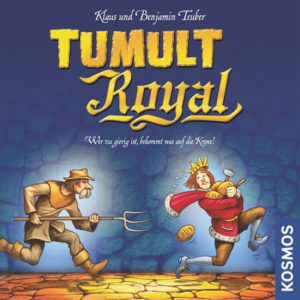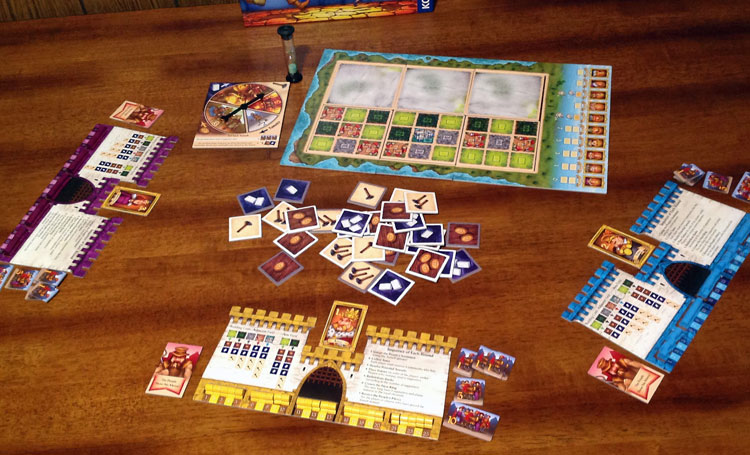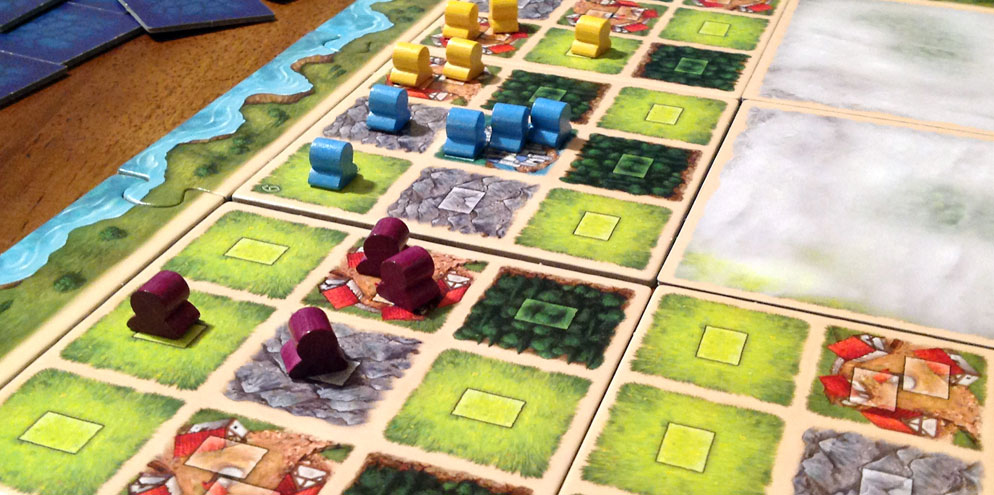 I’ll say this right up front: I’m not usually a big fan of real-time or speed games. I guess I’m the type of gamer who likes to take his time during his turns, planning each move carefully. can you say analysis paralysis? Maybe, but I won’t apologize for it.
I’ll say this right up front: I’m not usually a big fan of real-time or speed games. I guess I’m the type of gamer who likes to take his time during his turns, planning each move carefully. can you say analysis paralysis? Maybe, but I won’t apologize for it.
That being said, when I heard about the game Tumult Royale, I knew it had a speed element to it, yet it still seemed like a game I wanted to try. There were comparisons to Galaxy Trucker and other games of its ilk, where all players are simultaneously searching through a shared pile of components, and grabbing the best ones as fast as they can.
Whereas that game had you collecting parts for a spaceship and zooming off throughout the stars to find treasures on distant planets, Tumult Royale keeps the action on the ground, with a distinct medieval, tongue-in-cheek theme to it, adding some resource management and area control mechanisms as well. Also, this game is notable for having Klaus Teuber (of Catan fame) as its designer, in collaboration with his son Benjamin. Do all of these separate elements add up to a fun game? Let’s find out…
Game Overview:
In Tumult Royale, players take on the role of greedy, narcissistic royals who are trying to erect as many statues of themselves throughout the countryside as possible. This is done by taxing the poor peasants in order to acquire the commodities necessary to build the statues. Players need to be careful not to be too greedy, however, because the peasants may revolt, and players cannot afford to lose too many supporters! After as few as 6 and as many as 10 rounds, the player who has placed the most of his statues on the region board is the winner.
Game Components:

The main components of the game are the collection of commodity tiles, which the players will try to collect as fast and efficiently as possible. Each player will also get a set of 25 wooden statue figures. A player’s castle board will hold the commodity tiles collected each round, displays the player’s nobility (player order) card, and contains useful game information such as a building cost chart and a round overview. The supporter tokens will track the player’s overall popularity with the peasants.
A region board, consisting of 4, 6, or 8 region tiles, is where statues will be built, and also tracks the game rounds. The region tiles themselves each contain a random assortment of 9 fields.
Lastly, there is a spinner (!) to determine how many commodities the peasants want to keep for themselves each round, and a 20-second sand timer. Side Note: For those who prefer a more high-tech way of keeping time, Thames and Kosmos offers a free helper app with an easy-to-use timer that incorporates some “flavor” sound effects. Because the timer can be adjusted to various lengths, I would recommend getting it.
How to Play:
Each player starts with a castle board, 25 statues, and supporter tokens. The nobility cards are distributed at random, and will determine the player order. The region board is set up to one side of the table and starting statues are placed.
The first player begins the round by spinning the tumult spinner. The number indicated by the arrow shows how many commodities of each type must remain in the pile of tiles after players collect them during the tax phase. Each player then removes 3 commodity tiles from the pile without looking at them. These tiles will not be used or counted during the current round.

Players will be attempting to grab the commodities necessary to build their statues on the region board, and the castle board shows how many commodities of each type are needed to build in each type of landscape. Once all players are ready, the first player starts the timer. All players now have 20 seconds to collect commodities to use for the round.
Once the timer ends the unclaimed tiles are counted to check whether a tumult takes place. For each of the 3 commodities, if the amount remaining on the table is equal to or greater than the number on the spinner, the peasants are satisfied and no tumult occurs for that commodity. If, however, the total is less than the spinner number, a tumult will occur. The greediest player (with the most of that commodity) loses 3 supporters and may only keep the 1 lowest-value commodity tile of that type. Players can reduce the total number of all commodities they have taken by 1 each, if their mercy card currently shows the “people show mercy” side face up.
Next, in player order (as determined by the nobility cards), each player may place 1, 2, or 3 of their statues on 1 unoccupied field, as long as they have the commodities necessary to build where they want to.
After all players have built all of the statues that they can, the nobility cards are redistributed in order of the number of supporters each player has. At this point, the King must return 5 supporters to the supply, but gets to place one of his statues on the current round space on the region board.
Each round continues in the same way, with two additional notes. At the end of the 3rd and 5th rounds, 1 or 2 of the face down region tiles are turned face up, revealing new spaces for player to build statues on. Also, starting with the 6th round, the King of that round gets to place 2 of his statues on the round space instead of 1.
In addition, each time this happens, players check whether or not the game ends, by comparing the number of statues placed by the player who has placed the most and the player who has placed the least. If the difference of these 2 numbers is greater than the number printed on the region board under the current round space, the game ends and the player who has placed the most statues is the winner.
If, however, the difference is less than or equal to the printed number, the game continues to the next round. In any case, the game will end if players complete the 10th round. Finally, if any player manages to place all 25 of his statues on the board, the game ends immediately and that player is the winner.

Game Experience:
As mentioned earlier in this review, I’m not a big fan of real-time games so I honestly wasn’t sure what to expect with Tumult Royale. I think the gameplay itself is fine, and will definitely appeal to those gamers who like the thrill of working against the clock, but I found myself getting flustered whenever it came time to grab for the commodity tiles. I kept losing track of what tiles I already had on my board, so I would be constantly flipping them face up to remember, and that was costing me precious time to grab new tiles. I also felt that I wasn’t being efficient enough with my tile choices, but I soon realized that this was part of the game design, so I learned to accept it.

Should I grab 3 1-value marble tiles, or 1 3-value tile? The 3-value tile might allow me to gain some extra supporters (always important), but there’s the ever-present risk of taking too much and being penalized for it. If I play it safe and take less, will I have enough to build at least 1 statue? In some ways this is also a race game, with players all trying to keep up with each other in the statue building process.
I’ve played the game a few times before writing this review and one thing that struck me each time I played was a feeling of “is that all there is to this game?” I understand that the whole game is based mainly on the speed tile-grabbing mechanic, but even with the statue building element, the game just left me wanting something more. I can’t exactly put my finger on what that “something” would be. I admire the designers for trying a somewhat unique game, but I just wish it had a little more meat on its bones.
On a more positive note, I did like the components of the game. Everything worked well with the game, and even though I claimed there was not enough going on in the game for my tastes, the components, once laid out, sure do take up a good amount of table space, especially with the full 4-player count. The region tiles were nicely designed as well, and fit easily into the region board frame with no problems. The artwork was pleasing throughout, and was very evocative of the theme. I think that adding a spinner to the game was a nice touch, and even though I got a mixture of groans and chuckles when I showed the spinner to the other players, it was always commented on, it gave players a nostalgic feel, and it actually worked very well for the role it performed in the game.

Another thing I enjoyed about the game is that it didn’t take itself too seriously. Throughout all aspects of the game, whether it was the components, the artwork, the previously mentioned spinner, and even in the rule book, there was a playful, whimsical tone used, which kept the game pretty lightweight and tongue-in-cheek.
I think the idea player count for Tumult Royale would be with 3 players. Even though the number of commodity tiles is adjusted for each player count, there still seemed to be some differences to me. With 2, the game seemed a little too wide open, and neither player had much trouble getting the commodities they needed, so it wasn’t very challenging. With 4 players, the tile grab was too frantic (although this was probably by design), and I really had a tough time getting the right commodities in the right quantities. My 3 player game was the one I enjoyed most, and everything just seemed more balanced, including the claiming of region fields with statues. Obviously, this concept is true with just about any area control game, and it’s no different here.
Final Thoughts:
As I enter my sixth year as a full-fledged board gamer, I realize that I am becoming more and more critical of games. When I use the word “critical” I don’t mean that I’ll say a game is “bad” just because I don’t like it. What I mean is that I am much more specific in the types of games or game mechanics that I like, so I feel I am better experienced in making good game choices for myself, and I find it much easier to weed out games that don’t fit the bill for me.
Speaking of weeding out games, because of the ongoing problem of game storage space in an ever-growing collection, I’m also finding it easier to part with games in my collection that are just “ok”. Ultimately, I have to ask myself if I’m going to play a game enough in the future to justify its taking up space on my game shelves, and if the answer is “no”, I need to pass it on to someone who will get more enjoyment out of it.
I think this is where Tumult Royale falls for me. It does what it does well, but it just wasn’t enough of a game experience in my book for me to really enjoy it. I am confident that anyone who enjoys the real-time/speed mechanic in board games will also enjoy this game, and I hope they have a lot of fun with it. All in all, however, I’d have to say that Tumult Royale is a good game, but not exactly a great game, at least not to me. Your mileage, of course, may vary.
If you’d like to pick up a copy of Tumult Royale, you can get it for about $30.
Final Score: 3 stars – A game that will appeal to fans of the real time/speed genre; however I wish there was a bit more depth.
 Hits:
Hits:
• Nice components and colorful artwork.
• Easy to learn.
• Will appeal to gamers who enjoy the real-time/speed mechanic.
Misses:
• Just not enough “there” for me in the gameplay.
• If you’re not a fan of speed games, this game probably won’t change your opinion of them.
























I agree with your ultimate conclusion, but would say that this is a nice game for 8-12 year old siblings because there is fairly little “intent” like in so many other games where one person’s advantage is another’s detriment. You can build to box in someone, but it’s not key to success. And since you are grabbing tiles, it eliminates the “I never get a 6” kind of infantile frustration that plagues kids sometimes.
I want to also add specifically that the instructions to this game are soooo needlessly complex, getting lost in their own idiom far more than telling you how to set up and play. If you like “Catan” style instructions, then you’ll be ok with that. But there will be some things they just don’t tell you — like does the first “King” have to pay 5 supporters (makes it more competitive… but kinda arbitrary). They take a whole paragraph about how to randomize the initial royal roles, when they could just say: randomly assign the roles for the first round. Also, it’s hard to play this game on the floor if you have to “put tiles under the table and shuffle them”. LOL — only adult game geeks would think that way. Lastly, the sand timer is an inadequate element. First, my sand timer clocked in at 13 seconds, not even close to the 20 stated in the instructions. Secondly, for such a mad-dash grab game, the sand timer is easy to miss. For the MRSP of this game, they really needed to go for some kind of electronic (cheap) or mechanical (expensive) audible timer. They could even make a stupid app for phone with sound fx that complete the idiom, like audible sounds of rioting peasants, that culminate in a cannon blast when the time is up. But the creators appear not to have been that inspired… other than to get another paycheck.
I got this game for $5 at a closeout store. I would not pay more than that for it.